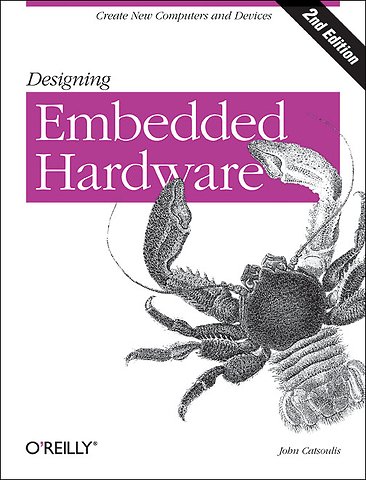Designing Embedded Hardware 2nd Edition
Create new computer and devices
Paperback Engels 2005 2e druk 9780596007553Samenvatting
Embedded computer systems literally surround us: they're in our cell phones, PDAs, cars, TVs, refrigerators, heating systems, and more. In fact, embedded systems are one of the most rapidly growing segments of the computer industry today.
Along with the growing list of devices for which embedded computer systems are appropriate, interest is growing among programmers, hobbyists, and engineers of all types in how to design and build devices of their own. Furthermore, the knowledge offered by this book into the fundamentals of these computer systems can benefit anyone who has to evaluate and apply the systems.
The second edition of 'Designing Embedded Hardware' has been updated to include information on the latest generation of processors and microcontrollers, including the new MAXQ processor. If you're new to this and don't know what a MAXQ is, don't worry-the book spells out the basics of embedded design for beginners while providing material useful for advanced systems designers.
'Designing Embedded Hardware' steers a course between those books dedicated to writing code for particular microprocessors, and those that stress the philosophy of embedded system design without providing any practical information. Having designed 40 embedded computer systems of his own, author John Catsoulis brings a wealth of real-world experience to show readers how to design and create entirely new embedded devices and computerized gadgets, as well as how to customize and extend off-the-shelf systems.
Loaded with real examples, this book also provides a roadmap to the pitfalls and traps to avoid. Designing Embedded Hardware includes:
- The theory and practice of embedded systems
- Understanding schematics and data sheets
- Powering an embedded system
- Producing and debugging an embedded system
- Processors such as the PIC, Atmel AVR, and Motorola 68000-series
- Digital Signal Processing (DSP) architectures
- Protocols (SPI and I2C) used to add peripherals
- RS-232C, RS-422, infrared communication, and USB
- CAN and Ethernet networking
- Pulse Width Monitoring and motor control
If you want to build your own embedded system, or tweak an existing one, this invaluable book gives you the understanding and practical skills you need.
Specificaties
Lezersrecensies
Inhoudsopgave
1. An Introduction to Computer Architecture
Concepts
Memory
Input/Output
DMA
Embedded Computer Architecture
2. Assembly Language
Registers
Machine Code
Signed Numbers
Addressing Modes
Coding in Assembly
Disassembly
Position-Independent Code
Loops
Masking
Indexed Addressing
Stacks
Timing of Instructions
3. Forth/Open Firmware
Introducing Forth
String Words
Stack Manipulation
Creating New Words
Comments
if ... else
Loops
Data Structures
Interacting with Hardware and Memory
Forth Programming Guidelines
4. Electronics 101
Voltage and Current
Analog Signals
Power
Reading Schematics
Resistors
Capacitors
RC Circuits
Inductors
Transformers
Diodes
Crystals
Digital Signals
Electrical Characteristics
Logic Gates
The Importance of Reading the Datasheet
5. Power Sources
The Stuff Out of the Wall
Batteries
Low Power Design
Regulators
LM78xx Regulators
MAX603/MAX604 Regulators
MAX1615 Regulator
MAX724 Regulator
Electrical Noise and Interference
6. Building Hardware
Tools
Soldering
Quick Construction
Printed-Circuit Boards
Building It
JTAG
7. Adding Peripherals Using SPI
Serial Peripheral Interface
8. Adding Peripherals Using I2C
Overview of I2C
Adding a Real-Time Clock with I2C
Adding a Small Display with I2C
9. Serial Ports
UARTs
Error Detection
Old Faithful: RS-232C
RS-422
RS-485
10. IrDA
Introduction to IrDA
11. USB
Introduction to USB
USB Packets
Physical Interface
Implementing a USB Interface
12. Networks
Controller Area Network (CAN)
Ethernet
13. Analog
Amplifiers
Analog to Digital Conversion
Interfacing an External ADC
Temperature Sensor
Light Sensor
Accelerometer
Pressure Sensors
Magnetic-Field Sensor
Digital to Analog Conversion
PWM
Motor Control
Switching Big Loads
14. The PIC Microcontrollers
A Tale of Two Processors
Starting Simple
A Bigger PIC
PIC-Based Environmental Datalogger
Motor Control with a PIC
15. The AVR Microcontrollers
The AVR Architecture
The ATtiny15 Processor
Downloading Code
A Bigger AVR
AVR-Based Datalogger
Bus Interfacing
16. 68HC11
Architecture of the 68HC11
A Simple 68HC11-Based Computer
17. MAXQ
Architectural Overview
Schematics
18. 68000-Series Computers
The 68000 Architecture
A Simple 68000-Based Computer
19. DSP-Based Controllers
The DSP56800
A DSP56805-Based Computer
JTAG
Index
Anderen die dit boek kochten, kochten ook
Rubrieken
- advisering
- algemeen management
- coaching en trainen
- communicatie en media
- economie
- financieel management
- inkoop en logistiek
- internet en social media
- it-management / ict
- juridisch
- leiderschap
- marketing
- mens en maatschappij
- non-profit
- ondernemen
- organisatiekunde
- personal finance
- personeelsmanagement
- persoonlijke effectiviteit
- projectmanagement
- psychologie
- reclame en verkoop
- strategisch management
- verandermanagement
- werk en loopbaan






